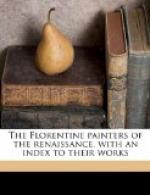Meanwhile we must continue our study of the naturalists, but now of the second generation. Their number and importance from 1460 to 1490 is not alone due to the fact that art education toward the beginning of this epoch was mainly naturalistic, but also to the real needs of a rapidly advancing craft, and even more to the character of the Florentine mind, the dominant turn of which was to science and not to art. But as there were then no professions scientific in the stricter sense of the word, and as art of some form was the pursuit of a considerable proportion of the male inhabitants of Florence, it happened inevitably that many a lad with the natural capacities of a Galileo was in early boyhood apprenticed as an artist. And as he never acquired ordinary methods of scientific expression, and never had time for occupations not bread-winning, he was obliged his life long to make of his art both the subject of his strong instinctive interest in science, and the vehicle of conveying his knowledge to others.
[Page heading: ALESSIO BALDOVINETTI]
This was literally the case with the oldest among the leaders of the new generation, Alessio Baldovinetti, in whose scanty remaining works no trace of purely artistic feeling or interest can be discerned; and it is only less true of Alessio’s somewhat younger, but far more gifted contemporaries, Antonio Pollaiuolo and Andrea Verrocchio. These also we should scarcely suspect of being more than men of science, if Pollaiuolo once or twice, and Verrocchio more frequently, did not dazzle us with works of almost supreme art, which, but for our readiness to believe in the manifold possibilities of Florentine genius, we should with exceeding difficulty accept as their creation—so little do they seem to result from their conscious striving. Alessio’s attention being largely devoted to problems of vehicle—to the side of painting which is scarcely superior to cookery—he had time for little else, although that spare time he gave to the study of landscape, in the rendering of which he was among the innovators. Andrea and Antonio set themselves the much worthier task of increasing on every side the effectiveness of the figure arts, of which, sculpture no less than painting, they aimed to be masters.
[Page heading: POLLAIUOLO AND VERROCCHIO]
To confine ourselves, however, as closely as we may to painting, and leaving aside for the present the question of colour, which, as I have already said, is, in Florentine art, of entirely subordinate importance, there were three directions in which painting as Pollaiuolo and Verrocchio found it had greatly to advance before it could attain its maximum of effectiveness: landscape, movement, and the nude. Giotto had attempted none of these. The nude, of course, he scarcely touched; movement he suggested admirably, but never rendered; and in landscape he was satisfied with indications hardly more than symbolical, although quite adequate to his purpose, which was to confine




